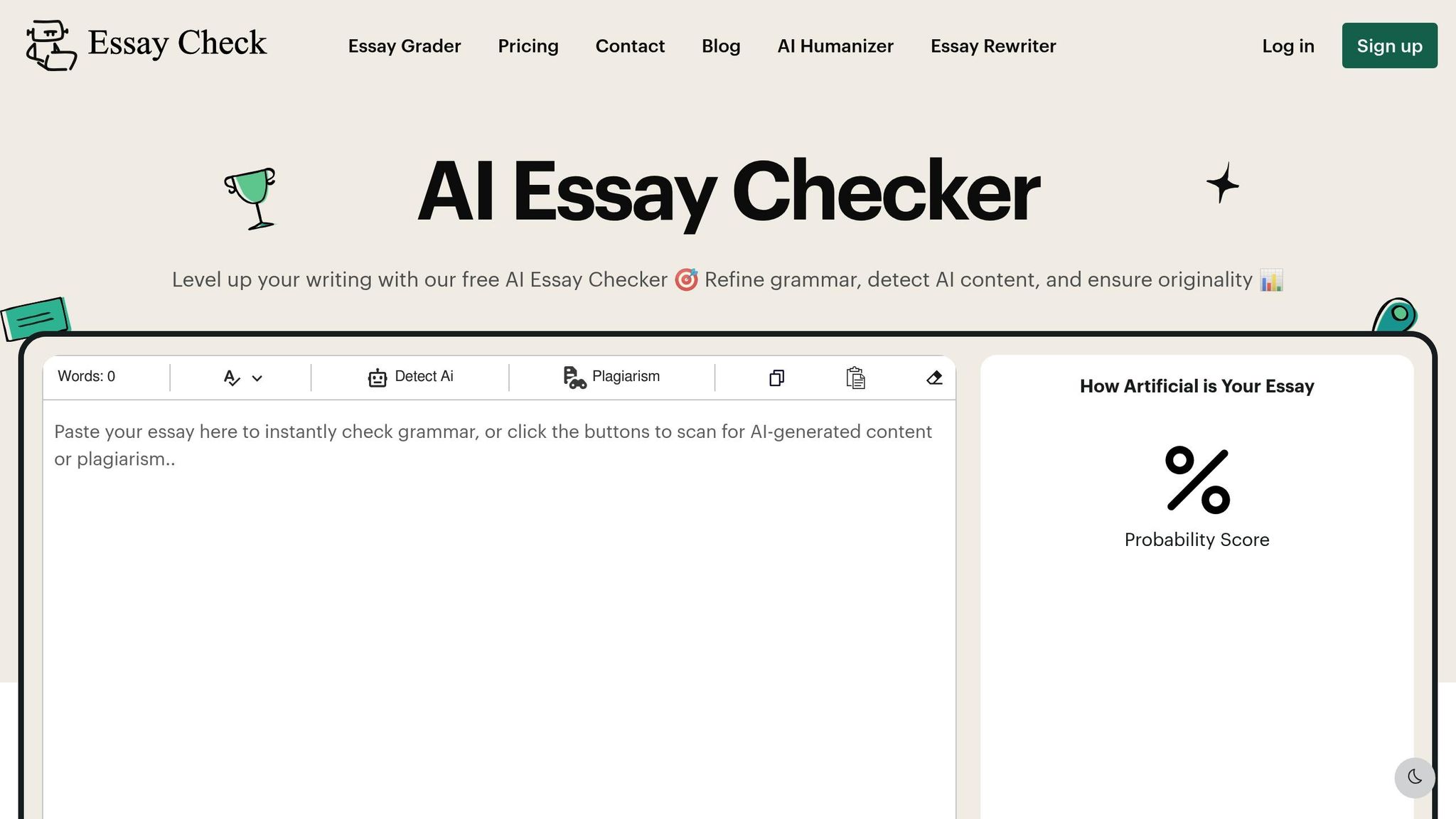Introduction Paragraphs 101: How to Grab Attention from the First Line
Crafting a strong introduction is essential for engaging readers and setting the tone for your essay. A great introduction includes:
- A Hook: Start with a question, surprising statistic, vivid scenario, or relevant quote to grab attention.
- Context: Provide background details to explain why your topic matters and define key terms without overloading.
- Thesis Statement: Clearly state your argument or main point in a concise, specific sentence.
Quick Tips:
- Use facts, questions, or short stories to create an engaging opening.
- Transition smoothly from general ideas to your thesis.
- Avoid clichés, overly long sentences, or vague statements.
By focusing on these elements, you can write introductions that are clear, engaging, and effective.
How to Write an Eye-Catching Essay Introduction | Scribbr 🎓
Key Parts of an Introduction Paragraph
Nailing the core elements of an essay introduction is crucial. Each part plays a role in grabbing attention and guiding your reader into the rest of your essay.
Opening Lines That Grab Attention
The first sentence, often called the "hook", is your chance to pull the reader in. Think of it as the gateway to your essay, where creativity meets purpose.
Here are some effective hook ideas:
- Thought-provoking questions: Questions that challenge the reader’s perspective or spark curiosity.
- Surprising statistics: Eye-opening numbers that highlight the importance of your topic.
- Vivid scenarios: Short, descriptive scenes that immerse the reader in the subject.
- Relevant quotes: Memorable statements from experts or influential figures.
"Think of an introduction as the first few notes of a song. Traditionally, a song does not start off with multiple instruments playing at once. It eases into the music with a little guitar riff here or maybe a drum solo there. The introduction to an essay is similar; you ease into the topic by presenting a little bit at a time, thus setting the tone for the rest of the essay."
Providing Context
After hooking your reader, offer background details that connect your opening to your thesis statement. This context should:
- Explain why the topic matters.
- Define any important terms or concepts.
- Clarify the scope of your essay by highlighting what you’ll focus on.
- Lay the groundwork so readers are prepared for your argument.
The trick is to give enough information to orient your audience without overloading them. Once the context is clear, your thesis will naturally follow.
Crafting a Strong Thesis Statement
The thesis statement is the backbone of your introduction. It clearly states your main argument and outlines what’s to come.
A good thesis statement should:
- Clearly present your argument or stance.
- Highlight the key points you’ll cover.
- Be placed near the end of your introduction.
- Use specific and concise language.
Together, these three elements - hook, context, and thesis - create a seamless introduction that transitions the reader from curiosity to understanding. Each piece builds on the last, setting the stage for your analysis.
3 Ways to Start Your Essay
A strong opening grabs your reader's attention and sets the tone for your essay. These strategies can help you craft an introduction that draws readers in and leads smoothly into your main argument.
Facts and Statistics
Using surprising or relevant statistics can immediately show why your topic matters. To make the most of this approach:
- Use recent, reliable data that ties directly to your subject.
- Clearly explain why the statistic is meaningful to your argument.
- Provide context to help readers understand its importance.
Don’t just throw out a number - connect it to your essay’s broader message. You can also ask a question related to the statistic to spark interest.
Questions That Make Readers Think
Asking thought-provoking questions is a great way to engage your audience. The best questions:
- Challenge assumptions or common beliefs.
- Highlight unexpected relationships.
- Encourage readers to reflect.
- Lead naturally to your thesis.
"Always have a road map for an essay introduction. Having a strong essay introduction structure is critical to a successful paper. It sets the tone for the reader and interests them in your work. It also tells them what the essay is about and why they should read it at all." - Scribendi
Make sure your questions are specific enough to guide readers toward your topic but open-ended enough to spark curiosity. Another option is to use a short story or example to illustrate your point.
Short Stories and Examples
Brief narratives can make complex ideas more relatable and create an emotional connection. For example:
The Amityville Horror case is a great way to use storytelling effectively. The tale of the Lutz family fleeing their New York home due to alleged supernatural events provides a striking entry point for discussing ghost stories and scientific investigation.
When using stories:
- Keep them concise.
- Choose ones that directly support your thesis.
- Use vivid, precise language.
- Transition smoothly into your main argument.
These techniques work best when they match your essay's tone, connect naturally to your thesis, and provide context while staying engaging and credible.
sbb-itb-fcf950d
How to Order Your Introduction
Build your introduction by starting with a broad overview and narrowing down to your thesis. Here's how to structure it effectively.
General to Specific Method
Organize your introduction using this sequence:
- Hook: Start with an engaging opener to grab attention.
- Background: Add context to help readers understand the topic.
- Narrow focus: Steer the discussion toward your argument.
- Thesis: Clearly state your main point.
"In such a pyramid, you begin by presenting a broad introduction to the topic and end by making a more focused point about that topic in your thesis statement." - UMGC
For example, if you're writing about drunk driving penalties, you might start with a gripping story, follow it with relevant statistics, and finish with a thesis advocating stricter laws.
When writing, ensure your sentences flow naturally from one to the next. The key is to link these elements smoothly to keep your readers engaged.
Connecting Your Ideas
| Introduction Element | Purpose | How to Connect |
|---|---|---|
| Hook to Background | Provide context | Use details that expand on your opener |
| Background to Focus | Narrow the topic | Highlight specific points tied to your argument |
| Focus to Thesis | Make your case | Show how the context leads to your main idea |
"The introduction to an essay is similar; you ease into the topic by presenting a little bit at a time, thus setting the tone for the rest of the essay." - Del Mar College
Every sentence should guide readers closer to your thesis. If a detail doesn’t serve this purpose, it’s better to leave it out.
Tips for Smooth Transitions:
- Make sure each sentence builds on the previous one.
- Keep the tone consistent throughout.
- Use transition words thoughtfully.
- Ensure ideas connect logically.
A well-crafted introduction feels effortless. Review your transitions to ensure clarity and flow.
5 Introduction Mistakes to Avoid
Steering clear of common mistakes is just as important as using effective techniques. Here are some pitfalls to watch for in your introduction.
Too Much Information
Your introduction should be concise and to the point. Avoid overcrowding by keeping an eye out for these issues:
- Background details that take up more than one paragraph
- Multiple examples or statistics when one is enough
- Information that belongs in the body of your essay
| Problematic Example | Improved Approach |
|---|---|
| Several historical examples | Use one relevant example |
| Long-winded topic background | Provide a brief overview |
| Multiple statistics | Highlight one impactful number |
| Multiple thesis points | Focus on a single, clear argument |
Overused Opening Lines
Cliché openers can weaken your essay and lose your reader's interest. Stay away from these:
- Dictionary definitions ("Webster's dictionary defines...")
- Broad historical claims ("Since the dawn of time...")
- Obvious statements ("In today's society...")
- A string of questions ("Have you ever wondered...?")
Instead, craft an engaging opener that ties directly to your topic and thesis. Use vivid details, a striking statistic, or a scenario that immediately draws the reader in.
Unclear Thesis Statements
A vague or weak thesis can derail your introduction. Compare these examples:
| Weak Example | Stronger Revision | Why It Works Better |
|---|---|---|
| "LGBTQ discrimination is a problem that needs to be solved." | "LGBTQ discrimination in America requires federal equality legislation to address the issue effectively." | Adds specificity and direction |
To create a strong thesis:
- Make it clear and supportable
- Keep it focused to one or two sentences
- Place it near the end of your introduction
- Directly address the assignment prompt
- Ensure it connects to your body paragraphs
Up next, explore tools and techniques to take your introduction to the next level.
Tools and Tips for Better Introductions
Reading and Editing Tips
Fine-tune your introduction with these three steps:
Read it aloud to catch awkward phrases or breaks in flow. If it feels clunky as you read, your audience will likely notice too.
1. First Review: Structure Check
Examine the overall framework:
- Does it transition smoothly from general ideas to specific points?
- Is your thesis statement easy to spot?
- Have you provided enough context without overloading the reader?
2. Second Review: Engagement Assessment
Evaluate your opening lines as if you were the reader:
- Do they make you want to keep going?
- Does the introduction spark interest without being over the top?
- Is the hook relevant to your main argument?
3. Final Review: Technical Polish
Focus on the technical details:
- Trim sentences longer than 25 words.
- Swap passive voice for active constructions.
- Cut out unnecessary adjectives and adverbs.
Address these common issues quickly:
| Problem | Solution |
|---|---|
| Long sentences | Remove extra prepositional phrases |
| Passive voice | Identify the subject and lead with it |
| Weak transitions | Use connecting words to link ideas |
| Vague statements | Add specific examples or data |
Once you've polished these areas, consider using technology to further refine your introduction.
Using EssayCheck Tools

After manual editing, boost your introduction's precision with EssayCheck. Their tools are designed to enhance clarity and impact:
Grammar Checker
This tool identifies and fixes technical errors that can weaken your introduction. It flags:
- Subject-verb agreement issues
- Punctuation mistakes
- Overly complex sentence structures
Essay Grader
With a free plan offering up to 10,000 words per month, the Essay Grader evaluates your introduction's effectiveness by analyzing:
- The strength of your hook
- Clarity of your thesis
- Relevance to the topic
- Quality of transitions
| Feature | Free Plan | Basic Plan ($10/month) |
|---|---|---|
| Grammar Checker | Unlimited | Unlimited |
| Essay Grader | 10,000 words/month | 50,000 words/month |
| Priority Support | No | Yes |
Use these tools alongside manual editing. While EssayCheck can catch technical flaws and structural gaps, your personal touch is key to creating an introduction that truly connects with readers.
Conclusion
Crafting an engaging introduction requires a clear strategy and careful refinement. By focusing on three key elements - a strong hook, relevant background, and a clear thesis - writers can set the stage for their arguments effectively.
Writing and revising go hand in hand. Many writers adjust their introductions after completing the entire essay to ensure it aligns seamlessly with the main argument and supporting evidence. This method lets you fine-tune your opening to match the essay's overall structure.
EssayCheck's tools make this process easier. Features like the Grammar Checker and Essay Grader help polish technical details while improving your hook and thesis. With the free plan's 10,000-word monthly limit, you have plenty of room to refine your introductions.
